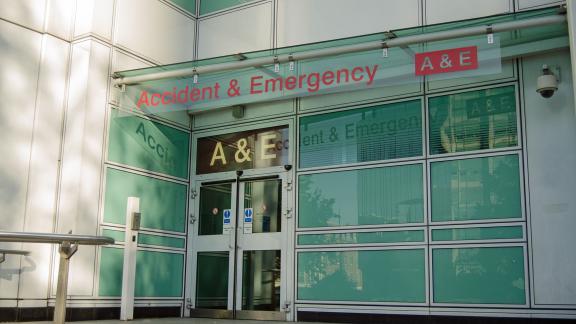Taking a holistic approach to the high-frequency A&E use in Sussex

The High Intensity Use project (HIU) is a de-medicalised, personalised holistic approach, commissioned by Sussex NHS Commissioners, to better meet the needs of local people who regularly attend A&E.
The two-year project started in October 2020 and the British Red Cross was chosen as partner, for its social prescribing and coaching expertise.
This partnership working has led to a significant reduction in A&E attendances, as well as a reduction in ambulance call-out rates.
Key benefits and outcomes
- Significant improvements in mental health for individuals in Sussex.
- 58 per cent reduction in A&E attendances.
- 38 per cent reduction in non-elective admissions.
- 72 per cent reduction in ambulance conveyances.
- Combined saving of £406,000 to date.
What the organisation faced
In the Sussex area, large numbers of residents were making repeat visits to A&E – a term commonly referenced as high-intensity use (HIU).
Statistically, this mirrors the national pattern, with deprivation and inequalities behind repeat A&E visits. HIU often stems from an individual’s struggle to cope with sudden life changes such as job loss, housing insecurity/ homelessness, relationship breakdown, or grief, combined with social and economic challenges. Loneliness and mental health issues are other common factors.
In the Sussex area itself, the largest HIU demographic were either young people aged 20-29 or older residents aged 65 and above. Feelings of loneliness and isolation were exacerbated during the pandemic amongst all age groups, but the younger cohort’s feelings of despair/ suicidal thoughts increased to such an extent that some were attending A&E several times a month, with one individual making almost daily visits.
This was costly on many levels, making it necessary for an intervention tackling the root cause of each individual’s attendance. The goal was to empower these individuals by equipping them with better life skills and help them to consider using alternative pathways to access help, rather than viewing A&E as a ‘drop-in’ service.
What the organisation did
Sussex NHS Commissioners commissioned the British Red Cross to provide holistic help, knowing the team had the skills and time to provide a range of social, emotional and practical support to these individuals. Success would be measured by a significant reduction in A&E attendances as well as a correlating reduction in ambulance call-out rates, both of which are costly spends.
Two full-time HIU leads and a part-time community connector were chosen to work on this project, although recruitment challenges meant only one lead was in the post for the initial six months. The work started once quarterly access to hospital data was received from the hospital’s community team, which provided the names and addresses of the top 200 HIU attendees.
The British Red Cross HIU team quickly found that making the initial contact is often the trickiest part. Not everyone has access to, or indeed will want to, pick up a phone. One HIU lead found that taking a personalised approach was really effective, as many service users will respond positively to receiving a card through their door, rather than a phone call. This card includes a brief but friendly word of introduction expressing concern for the individual and leaving contact details. It is often the first time anyone outside a clinical setting has taken an interest in them.
A common follow up is often an invitation to meet for a coffee and chat. This work was allowed to continue even during the second lockdown, as it was deemed an emergency scenario.
The HIU team found that loneliness, isolation and mental health difficulties were common reasons behind HIU. One young woman genuinely feared she had cancer and her worries were exacerbated by being unable to access a face-to-face appointment with her own GP. Being assigned the support meant an appointment with another GP was quickly arranged, and the tests came back clear. Following this reassurance, she no longer needed to attend A&E.
Although this and some other cases encountered were a relatively ‘easy fix,’ having an impact within three to six months, some client cases are more complex and illustrate the importance of the support worker being able to quickly liaise with all the agencies, including GPs, ambulance service, police, and mental health teams.
This case is a young woman in her 20s, with a mild borderline personality disorder and history of abuse, whose child was taken into care following the breakdown of her relationship. This led to a destructive pattern of self-harm/suicide attempts and higher than expected A&E attendances.
The lead quickly met with the client’s social worker to liaise on a support plan. The lead's intervention quickly established trust and the crisis point was averted when one of her first priorities - arranging unsupervised contact visits with the client’s child – started.
A strong bond was established between the HIU lead and client and, more importantly, the client hasn’t attended A&E once since the intervention, with the exception of one visit for a respiratory medical emergency. The longer-term plan is for support to be provided by a combination of the individual’s social worker and mental health support worker.
Results and benefits
This project’s success is partly attributable to the fact the Red Cross team has the time to provide holistic care to every person who attends A&E more frequently than expected. The team also has the expertise to liaise with all other partners involved in an individual’s care.
Social prescribing timelines are typically six weeks, but the Red Cross HIU team can occasionally make an impact within three to six weeks. This is impressive given that half their client base is aged from 18 to 25, are hard to engage with and find it difficult to open up.
Although the study range is currently limited, because an HIU lead has a limit to the number of cases they can take on, the early results for Sussex look promising, with the initial 12-month period showing a 58 per cent reduction in A&E attendances.
Additionally there has been a 31 per cent reduction in non-elective admissions and a 72 per cent reduction in ambulance conveyances, collectively saving around £406,000 and showing an upward trajectory as the project continues.
This project is also undoubtedly saving lives. The intervention for one high-risk HIU individual, who had previously attempted suicide 15 times in a 12-month period, resulted in significant improvements to his quality of life, with no further reported visits to A&E. Another client told the project lead that the support provided to her meant that it was the first time in her life that she felt safe.
Overcoming obstacles
The data provided by the hospital is scant, as the reasons given for HIU given are often brief, so there is limited intelligence to work from. Although the support workers have the ability to liaise with all the agencies, it sometimes takes a while to establish trust with a client before this information is revealed. Fortunately, the three-to-six-month timeline assigned to each case means the information does come through eventually.
Takeaway tips
- Some cases that appear initially to be a ‘quick fix’ often take longer than anticipated, and the ones that seem trickier may be quicker.
- Partnership working is fluid and quickly leads to enhanced results. Even when a team member leaves, the initial established contact is strong enough for the good work to continue.
- Accept that you can’t help everyone all the time. Some people just won’t respond to any form of contact or intervention. However, for receptive individuals the win is multifaceted, with visible improvements to their life trajectory and health outcomes, and it can be life-saving.
Further information
For further information about the work in this case study, contact Nikki St Aubyn, HIU programme delivery manager with the British Red Cross:
NikkiStAubyn@redcross.org.uk



